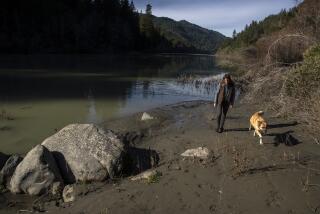Dinosaur discovery in Alaska: A duck-billed herbivore that didn’t fear the snow
In a remote area of northern Alaska, scientists have discovered a duck-billed dinosaur the size of a minibus that roamed above the Arctic Circle roughly 70 million years ago.
The newly described herbivore was dubbed Ugrunaaluk kuukpikensis (pronounced oo-GREW-na-luck KOOK-pik-en-sis), which means “ancient grazer of the Colville River” in the Inupiaq language. It was one of more than a dozen species of dinosaurs that lived surprisingly close to the North Pole.
“When we think of dinosaurs, we think of them living in a tropical paradise,” said Patrick Druckenmiller, a vertebrate paleontologist at the University of Alaska Fairbanks who described the new find this week in the journal Acta Palaeontologica Polonica. “For these dinosaurs, it was more like an Arctic paradise.”
Ugrunaaluk kuukpikensis, which grew to 25 feet in length, had some interesting company. Other dinosaurs found in the same bone deposit include a pygmy tyrannosaur and a horned dinosaur with a fancy frill.
All of these creatures were discovered at a site known as the Prince Creek Formation. Paleontologists have been excavating the area since the 1980s.
When these dinosaurs were alive, the formation was at about 80 degrees latitude, well above the paleo-Arctic Circle. Over time, it has moved south to about 70 degrees latitude, due to the shifting of the Earth’s crust.
If you’re wondering how dinosaurs managed to survive in the Arctic temperatures we know today, the answer is, they didn’t.
Back when Ugrunaaluk kuukpikensis roamed, the Arctic was a more hospitable place, with average temperatures around 45 degrees Fahrenheit. Evidence from fossilized pollen suggests these dinosaurs lived in a conifer forest with an understory that included flowering plants, ferns and horsetails.
“It was probably comparable to what you would find in Juneau, Alaska, down in the panhandle of the state,” Druckenmiller said. “It wasn’t a warm winter, but it was much warmer than it is today.”
There are several ways a dinosaur could survive in those temperatures, experts said. The meat eaters might have been covered with feathers to provide insulation against the cold, while the plant eaters may have been good at storing fat.
It’s also possible that the dinosaurs were able to slow their metabolism in the winter months to contend with a more limited food supply.
“Modern animals that live up there today like caribou and wolves don’t hibernate, but they do adjust their metabolic rates,” said Anthony Fiorillo, chief curator at the Perot Museum of Nature and Science in Texas who has worked in northern Alaska for 18 years. “I suspect we would see the same thing in dinosaurs.”
Perhaps they already have.
“There is some suggestion that we are seeing seasonality in bone growth, which would support that hypothesis,” said Fiorillo, who was not involved in the study.
It is also incorrect to assume that a dinosaur’s internal temperature was entirely dependent on the external temperature, like some lizards today.
“They were definitely not like a typical lizard in their morphology,” Druckenmiller said. “We all agree that they had some elevated metabolism and body temperature.”
More than the cold, the big challenge for Ugrunaaluk kuukpikensis and its Arctic contemporaries may have been the long polar night. Between mid-October and mid-February, the sun never rose.
“That’s what is particularly intriguing about it all,” Fiorillo said. “Sure, you can warm the place up, but you still have some profound seasonality in the form of light fluctuations.”
Several lines of evidence suggest the community of northern dinosaurs did not migrate south during the winter. That means they would have needed to know how to move around in the dark and find food at a time when plants were scarce.
“Moose could be a good analogue,” Druckenmiller said. “They fatten themselves up in the summer and survive on conifer needles in the winter. There’s no reason these dinosaurs weren’t doing the same thing.”
Paleontologists said there is still a lot more to learn from the Prince Creek Formation, though the excavation work is treacherous and expensive. To get to the site, the researchers first have to take small planes or helicopters. Then they board inflatable boats and use the rivers like highways.
“People picture dinosaur digging taking place in the hot summer weather in some desert-y situation,” Druckenmiller said. “We are totally dressed up in full winter gear, and it is 45 degrees and sleeting on us.”
Despite these difficulties, small teams of paleontologists working for 10 to 14 days at a time have pulled thousands of bones from the fossil bed.
So far, they have found 6,000 bones from Ugrunaaluk kuukpikensis alone.
“It’s the one we know better than any other,” said Druckenmiller, who helped find some of the fossils. “We have every bone in its body.”
Thomas Carr, a paleontologist at Carthage College in Kenosha, Wis., said the dinosaur species described so far are just the tip of the iceberg.
“I expect that many new fossils will be found of the dinosaur species we know about, and that many hitherto undiscovered species will come to light,” said Carr, who was not involved in the study. “We are currently enjoying a renaissance of Arctic dinosaurs.”
Fiorillo agreed: “It would not surprise me to see more new animals coming out of the ancient Arctic.”
Science rules! Follow me @DeborahNetburn and “like” Los Angeles Times Science & Health on Facebook.







